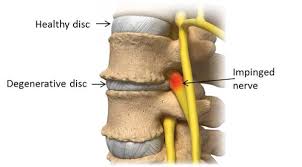Degenerative Disc Disease is commonly called DDD. There are two main types which are Cervical Degenerative Disc Disease and Lumbar Degenerative Disc Disease. To understand about Degenerative Disc Disease, one needs to understand about the purpose of these discs. There are discs in between the vertebrae throughout the neck, mid, and low back. These discs act as natural shock absorbers helping to stabilize the spine. As time goes on, these discs become worn and start to degenerate. When the space becomes smaller, the disc tends to bulge out or herniate causing the nerve roots to become pinched.
In the neck, symptoms of Degenerative Disc Disease are neck pain and stiffness. If there is pressure on the nerve from a disc, it can also cause pain, numbness, or weakness radiating down your shoulder, arm, and hand. Common tests to look at this process are Xrays, magnetic resonance imaging (MRI), and computed tomography (CT).

There are several lines of treatment for Degenerative Disc Disease. The first line of treatment is over the counter medications including Tylenol and NSAIDs such as Advil. If these medications aren’t helping with pain then the next line of treatment may include steroids and/or narcotics. Another line of treatment is physical therapy and a home exercise program. A therapist can perform treatment such as traction, manipulations, and exercises/stretches helping with pain and range of motion. If the neck symptoms do not improve with conservative treatment, other lines of treatment are epidural steroid injections and surgery. If someone has significant numbness or weakness then surgery becomes a treatment option. The primary surgery for DDD is called a discectomy. After the physician performs the discectomy, then it is followed with an artificial disc replacement or cervical fusion.
Degenerative Disc Disease is most commonly often due to age, but can be influenced by lifestyle factors. Ways to promote better spine health include eating a balance diet and exercising regularly. Smoking is a risk factor for Degenerative Disc Disease. Other things to help prevent DDD are maintaining a good posture keeping your neck straight and back supported.